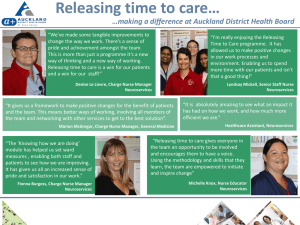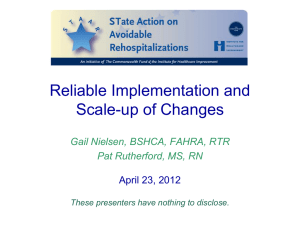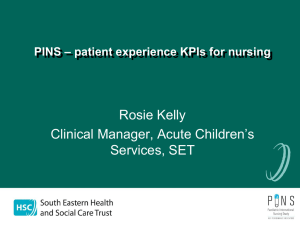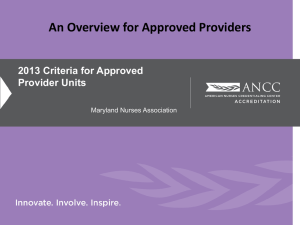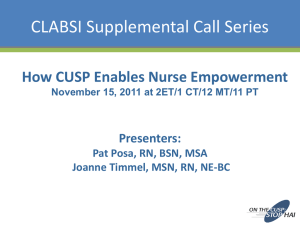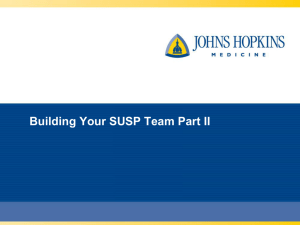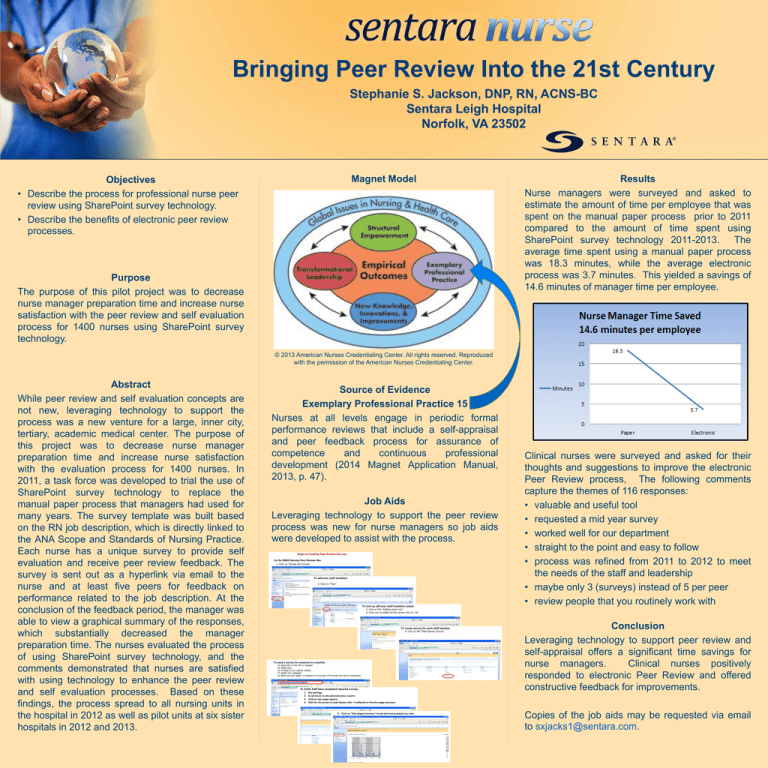
Bringing Peer Review Into the 21st Century
Stephanie S. Jackson, DNP, RN, ACNS-BC
Sentara Leigh Hospital
Norfolk, VA 23502
Objectives
• Describe the process for professional nurse peer
review using SharePoint survey technology.
• Describe the benefits of electronic peer review
processes.
Magnet Model
Purpose
The purpose of this pilot project was to decrease
nurse manager preparation time and increase nurse
satisfaction with the peer review and self evaluation
process for 1400 nurses using SharePoint survey
technology.
Results
Nurse managers were surveyed and asked to
estimate the amount of time per employee that was
spent on the manual paper process prior to 2011
compared to the amount of time spent using
SharePoint survey technology 2011-2013. The
average time spent using a manual paper process
was 18.3 minutes, while the average electronic
process was 3.7 minutes. This yielded a savings of
14.6 minutes of manager time per employee.
© 2013 American Nurses Credentialing Center. All rights reserved. Reproduced
with the permission of the American Nurses Credentialing Center.
Abstract
While peer review and self evaluation concepts are
not new, leveraging technology to support the
process was a new venture for a large, inner city,
tertiary, academic medical center. The purpose of
this project was to decrease nurse manager
preparation time and increase nurse satisfaction
with the evaluation process for 1400 nurses. In
2011, a task force was developed to trial the use of
SharePoint survey technology to replace the
manual paper process that managers had used for
many years. The survey template was built based
on the RN job description, which is directly linked to
the ANA Scope and Standards of Nursing Practice.
Each nurse has a unique survey to provide self
evaluation and receive peer review feedback. The
survey is sent out as a hyperlink via email to the
nurse and at least five peers for feedback on
performance related to the job description. At the
conclusion of the feedback period, the manager was
able to view a graphical summary of the responses,
which substantially decreased the manager
preparation time. The nurses evaluated the process
of using SharePoint survey technology, and the
comments demonstrated that nurses are satisfied
with using technology to enhance the peer review
and self evaluation processes. Based on these
findings, the process spread to all nursing units in
the hospital in 2012 as well as pilot units at six sister
hospitals in 2012 and 2013.
Source of Evidence
Exemplary Professional Practice 15
Nurses at all levels engage in periodic formal
performance reviews that include a self-appraisal
and peer feedback process for assurance of
competence
and
continuous
professional
development (2014 Magnet Application Manual,
2013, p. 47).
Job Aids
Leveraging technology to support the peer review
process was new for nurse managers so job aids
were developed to assist with the process.
Clinical nurses were surveyed and asked for their
thoughts and suggestions to improve the electronic
Peer Review process, The following comments
capture the themes of 116 responses:
• valuable and useful tool
• requested a mid year survey
• worked well for our department
• straight to the point and easy to follow
• process was refined from 2011 to 2012 to meet
the needs of the staff and leadership
• maybe only 3 (surveys) instead of 5 per peer
• review people that you routinely work with
Conclusion
Leveraging technology to support peer review and
self-appraisal offers a significant time savings for
nurse managers.
Clinical nurses positively
responded to electronic Peer Review and offered
constructive feedback for improvements.
Copies of the job aids may be requested via email
to sxjacks1@sentara.com.




